Stroud Scientists at Work
A Seeker of the Truth
By Jamie Blaine
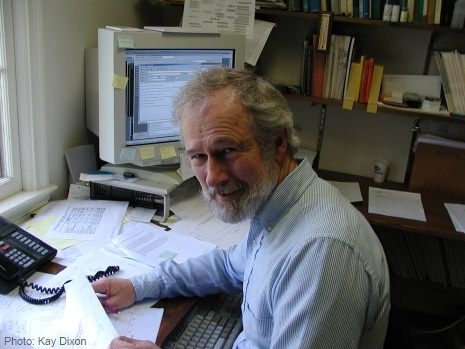
Denis Newbold holds both strong political beliefs and an absolute commitment to scientific rigor. In an age when science is under fire for being politicized and politics seems incapable of nonpartisanship, this is not an easy place to be.
“The connector,” said Newbold, who retired last December as head of Stroud™ Water Research Center’s Ecosystem Processes group, “is truth …. I try to be as honest as I can, never twisting the truth in either politics or science.
“It comes from my Quaker background,” he said. “Early Quakers called themselves Seekers of the Truth, and this led them to the principles of simplicity, equality, honesty, and nonviolence. It also led a surprising number of Quakers to become scientists.”
FROM ENGINEER TO ENVIRONMENTAL SCIENTIST
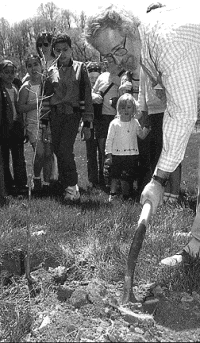
Denis Newbold came of age with the development of streams and rivers as a critical area of scientific study. In fact, H. B. N. Hynes’s The Ecology of Running Waters, the book that did more than any other to legitimize the field, came out in 1970. That was the year that Newbold, then a summer intern from Swarthmore College, produced a plan recommending that Newtown Township plant trees along its stream corridors. It was also the year that Gene Likens published his classic study of the Hubbard Brook watershed and that the Stroud Center embarked on the five-year national research project that produced the River Continuum Concept (RCC). The first Earth Day was April 22, 1970, and it was at around that time that Jack Webster began his work on spiraling, the scientific concept that would come to be closely associated with Denis Newbold.
Serendipity? Sure, but not necessarily coincidental. “Earth Day was a godsend for me,” said Newbold, who describes himself at the time as an engineering student wondering, “What can an engineer do that is not destructive?” When his aunt handed him an article about an interdisciplinary team of scientists working on environmental issues, he had a kind of epiphany: “I saw, for the first time, that disciplines need not be barriers — they could be connectors.” That was exactly the direction in which river studies were heading, and it would be the fundamental premise of the RCC — and the foundation of the team concept that continues to drive scientific research at the Stroud Center, where Newbold has worked since 1983.
A QUAKER AT OAK RIDGE
After taking a master’s degree in hydrology at Cornell and a Ph.D. in aquatic ecology at the University of California at Berkeley, Newbold’s transition from engineer to environmental scientist was complete, and he set off for the Oak Ridge National Laboratory in Tennessee. Oak Ridge, which was set up as part of the Manhattan Project to produce the first atomic bomb, might seem an odd fit for a man of his Quaker background and liberal politics. But after World War II, Oak Ridge shifted to peacetime research, and Newbold arrived just as it was becoming a major force in the new field of stream studies.
In particular, Oak Ridge scientists were focusing on phosphorus. Long a major ingredient in fertilizers, phosphorus had also become a staple of laundry detergents by the 1950s. In the late 1960s, however, researchers demonstrated a clear link between phosphorus and the enormous algal growth that was killing lakes, most famously Lake Erie. Following those lake studies, Oak Ridge scientists wanted to know the impact of phosphorus on streams and rivers. Their goal was not simply to pursue applied research on the effect of detergents, but to gain basic insights into the structure and function of a river’s ecosystem.
Because of its history with nuclear reactors, Oak Ridge had something that was not available to research scientists elsewhere: radioisotopes, whose radioactivity makes them far easier to trace in both nature and the laboratory than the elements themselves. Of course, researchers must dress up like spacemen to work with isotopes; scientists have a long and honored history of poisoning themselves for their work.
SPIRALING AND THE RIVER CONTINUUM
The key to understanding the ecosystem lies in understanding the nutrient cycle, in which inorganic nutrients are taken up by microbes and plants, journey through the food web, and return to an inorganic form to cycle again. In a river, however, nutrients continually move downstream — which led Jack Webster, a graduate student at the University of Georgia, to ask a simple question: Does it make sense to talk about nutrient cycling in a stream? What he proposed was that because the nutrients do not complete a cycle until they have moved far downstream, the word spiraling more accurately describes the process.
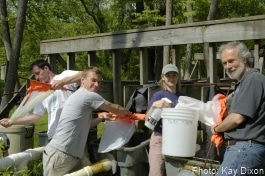
Newbold arrived at Oak Ridge just when the concept of spiraling was allowing new insights into stream ecosystems. What the concept lacked, however, was a way of measuring what researchers believed was happening — and Newbold devised the mathematical formulae that enabled the scientists to connect the data to the concept.
Concurrently, scientists at the Stroud Center were refining the RCC. Both concepts envision a longitudinal system in which what happens upstream affects what happens below, and both theorize about the life cycles of the nutrients through which the upstream-downstream effects are transmitted. At first, researchers at the two institutions were wary of each other as they simultaneously developed their groundbreaking ideas. Although both concepts soon gained wide acceptance among stream and river ecologists, it’s now clear that the Stroud Center’s Robin Vannote formulated the more important theoretical construct — and the RCC remains the most widely cited paper on streams and rivers ever published. The enduring legacy of spiraling is that it has enabled researchers to refine and test the broader conjectures of the RCC. Newbold, working with colleagues Lou Kaplan and others, built his nearly 30-year career at the Center by applying the more rigorous, mathematical-based theory of spiraling to the fundamental questions posed by the RCC.
THE ADVANCE OF TECHNOLOGY
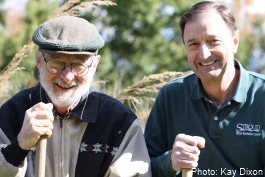
At the Stroud Center, Newbold was one of the earliest proponents of computer technology. To pursue his work with ecosystem models, he acquired the Stroud Center’s first powerful computer and directed computing and data management until a formal department of information services was created. Yet he worries about the ability of technology to produce so much data that it may overwhelm the scientist’s primary responsibility to ask “essential questions.”
“My fear,” he said, “is that technology will drive the science. We can now collect far more data at far less cost than ever before, which enables us to see things we never saw before — including how often we have been wrong because we did not see the whole picture. But there is a layer under that, which is the questions we ask in advance,” and the essence of science is defining those questions as “parsimoniously” as possible. After all, both the RCC and spiraling began as questions that were refined into hypotheses. The data came later.
“Still,” he says with a self-deprecating shrug, “I was wrong about the internet. I just laughed at it when I first saw it.”
And that brings us full circle. For Denis Newbold is a humanist even more than he is a scientist. He is more interested in posing the best question than in finding the right answer. He is driven by wonder more than by data. His lifelong quest has been to seek the truth, not to record the facts.
Introducing Our Post-Doctoral Researchers’ CZO Work
By Jamie Blaine
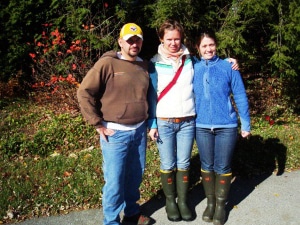
“Fresh waters and the carbon they transport play a major role in the global cycling of greenhouse gases.” — Anthony Aufdenkampe, Associate Research Scientist, Stroud Water Research Center.
A YEAR IN REVIEW
2011 witnessed the completion of the second full year of the collaboration between Stroud Water Research Center and the University of Delaware on the Christina River Basin Critical Zone Observatory (CRB-CZO). The goal of the NSF-funded CZO is to increase both scientific understanding and public awareness of how the water, mineral, and carbon cycles interact in the critical zone (defined by scientists as “the portion of the planet from the treetops to the groundwater that sustains terrestrial life”) to affect global climate change.
The program’s accomplishments last year included:
- Providing new corroboration for earlier studies by Anthony Aufdenkampe, who is the CRB-CZO’s co-principal investigator, and others indicating that rivers transport far more carbon than scientists had believed, most of which is either returned to the atmosphere as CO2 or buried in sediment;
creating low-cost, open-source wireless sensor networks that have the potential to radically transform critical zone science. - Developing web applications, such as WikiWatershed and Model My Watershed®, as innovative resources for research, education and public outreach programs.
- Educating the public about the impact of land use on carbon cycling, water quality, and climate change through a series of workshops, lectures, publications, and programs for researchers, policymakers, teachers, students, and informal educators.
POST-DOCTORAL RESEARCH
Last year also witnessed the most extensive use of post-doctoral researchers in Stroud Water Research Center’s 45-year history, as four newly minted Ph.D.s made significant contributions to the CZO project:
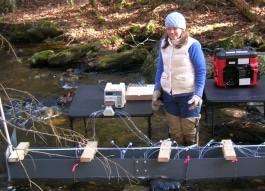
Diana Karwan, a hydrologist with a doctorate from Yale, has become known at the Center for something called “dial-a-pump.” Created in partnership with Shannon Hicks and Dave Montgomery, the process enables Diana to collect water samples in a 55-gallon drum by literally dialing up an on-site pump from her cell phone and telling it to get to work pumping water into the barrel. She collects the water primarily during storms, which is when most sediment moves — and when it is most problematic for a human to be physically working in a stream. Diana requires huge volumes of water to extract the amount of sediment she needs to do a variety of chemical experiments that will enable her to track the movement of the sediment in the stream and the sources of those sediments. By comparing the stream samples with ones she has taken from a variety of landscapes — open fields, cropland, flood plains, urban sites, and forests — she can determine where the sediment came from. With the help of additional hydrologic and statistical models, she can investigate how sediments and organic particles react as they move through the stream. Understanding how streams process sediments — in lay terms, where the murkiness comes from in a stormy stream — has enormous implications for improving land-management practices, both to protect fresh water and to reduce carbon emissions to the atmosphere. “Water is the connector moving everything,” she said. “We need clean water, and I want to understand how streams process material as it moves through the stream network.”
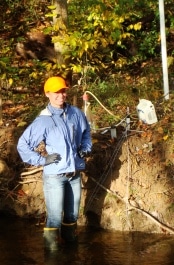
After receiving her undergraduate degree in environmental geology from Lomonosov Moscow State University in 2002, Olesya Lazareva moved to the University of South Florida for graduate study on the release of arsenic from a limestone aquifer. Arsenic is an extremely carcinogenic metal, and its presence in drinking water has become a worldwide problem. In 2006 the U.S. Environmental Protection Agency drastically reduced the legal levels of arsenic in water, and Olesya’s Ph.D. research was part of a broader project to reclaim a phosphate mine and determine if a wetland built on the site could become a potential pre-treatment option for aquifer storage and recovery, as well as for the remediation of elevated levels of arsenic. Now she is applying what she learned in south Florida to a study of the biogeochemical transformation of iron and manganese (two other heavy metals) and carbon across a wide range of land uses in White Clay Creek watershed. Olesya works as part of a team of soil scientists, chemists, biologists, and hydrologists whose goal is to advance our understanding of how human activities affect the carbon cycle. Using the Center’s real-time monitoring sensors, which allow them to see “what’s really going on in the soil,” said Olesya, the research team hopes to integrate knowledge of the distinct but interrelated cycles of water, minerals, and carbon. Bringing together such a diversity of scientific disciplines in a single study has been very exciting, she said, for it has until now been “a major missing link in critical zone science.”
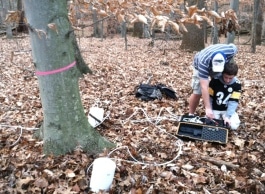
Carl Rosier brought his Ph.D. in soil microbiology and biochemistry from the University of Montana to learn more about how tiny organisms process carbon in the soil. In particular, he is studying what causes microorganisms to wear down mineral surfaces in the soil and what impact that has on carbon sequestration. Practices ranging from farming to development — and events as different as a raging storm and a falling tree — disrupt the soil and diminish its capacity to bind and hold carbon. One of the primary goals of the CRB-CZO is to determine what happens to that carbon and to quantify how much of it returns to the atmosphere as carbon dioxide. Carl believes that understanding how microbial communities in the soil respond to different land uses has important implications for climate change models. He is also looking at how different tree species process rainwater and what implications that might have for the soil processes he is analyzing. Beech trees, for example, behave like giant straws, channeling water down the surface of their trunks to their shallow roots. On the other hand, the rain drips from the leaves and branches of poplars, and the quantity and quality of the water reaching the ground below may have a significantly different impact on the soil’s microbial diversity. One of the attractions of this area for Carl is what he believes is its proximity to family in Pittsburgh — a concept that makes perfect sense if you used to live in Montana.
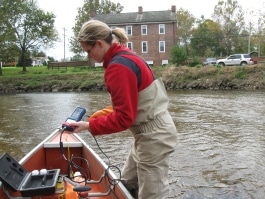
As the public’s obsession with pharmaceuticals in its drinking water made clear a few years ago, streams and rivers carry a lot of chemicals. The focus of Audrey Sawyer’s research is to understand what happens to chemicals as they move from the land to the stream and then down to the estuary and ultimately into the ocean. She has set up research sites at three very different settings: (1) a forested third-order tributary to White Clay Creek; (2) a tidal section of the creek just before it enters the Christina River above Wilmington; and (3) the river’s brackish estuary at Indian River Bay. The chemistry of the water varies at each site, as do the processes that drive the interactions between groundwater and surface water. It is those interactions that she is studying, particularly as they manifest themselves during large events: the great pulses of water that discharge into the stream during storms; the ebb and flow of the urban river in response to the tides; the run-off of chemical-rich groundwater from the surrounding shores directly into the bay; and the movement of the bay water through the estuary’s shallow sediment. “My goal is to understand how the tides, waves, and storms affect the flow of chemical contaminants on their journey through the watershed,” said Audrey. “Those processes can tell us a lot about the health of the entire system.” A hydrogeologist with a Ph.D. from the University of Texas, Audrey has come back to the area where she first learned to love the streams in which her parents taught her to fly fish as a child.
CZO: A NATIONAL PROGRAM
The CRB-CZO is one of six projects across the country that together compose a huge multiyear, interdisciplinary effort funded by the National Science Foundation. The CZO work is focused on quantifying the impact that humans have on carbon sequestration across an entire watershed — from upland headwaters to the ocean. Its overarching goal is to create models that can predict how the critical zone will respond to changes in land use, water quality, and climate. A key component of the study is to understand the role that streams and rivers play in the transport and sequestration of carbon, something the Stroud Water Center has been doing since 1967.
From Dreams to Reality: Anthony Aufdenkampe Tackles Earth Sciences’ Technology Landscape
By Diane Huskinson
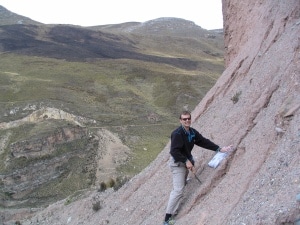
THE ADVENTURE BEGINS
There are those who dream and those who live the dream. Anthony Aufdenkampe is both. Whether he’s scaling an icy cliff, trotting the globe in pursuit of scientific discovery, or turning one-size-fits-few technology on its head, he doesn’t back down from a challenge. In fact, try telling him something is impossible, and you might just see a twinkle in his eye. For him, it’s an adventure, and his enthusiasm is contagious.
“Science is the endeavor of creating new knowledge. When you boil it down to that, it’s really exciting. It’s like walking on the moon — going somewhere no one else has ever been before,” he says.
Even as a child, he was drawn to the unknown and the outdoors. At the age of 8, he braved a transatlantic flight by himself en route to visit his grandparents, and growing up, he spent summers and weekends backpacking, canoeing, hiking, and camping with his family. Nature was his playground. As for his lasting love of rivers and oceans, those mysterious underwater worlds teeming with life, he credits first his boyhood hero. “I was really taken by Jacques Cousteau. I loved everything that had to do with oceans and water. I still do.”
By the time he graduated from Dartmouth College, he had become an accomplished whitewater kayaker, even leading expeditionary trips all over the East Coast. Rivers became his second home. He found them beautiful, dangerous, and good for a sweet ride. He was hooked. But he also wanted to understand the flows of energy and nutrients that sustained them. That desire led him on an educational journey to study freshwater ecosystems in Bolivia’s Beni River, Peru’s Ucayali River, Papua New Guinea’s Fly River, Africa’s Congo River, and the world’s largest river — the Amazon.
IRMS TECHNOLOGY
He matured as a scientist as the field of biogeochemistry was emerging, and he readily adapted his training in chemistry as a tool to understand how biology, geology, and hydrology interact on the earth’s surface. He believes that great ideas can come from unexpected places, and sometimes that means carving a new path to reach a better understanding of life on Earth. One such path: cutting-edge technology.
Since joining Stroud™ Water Research Center in 2003, Aufdenkampe’s imagination and thirst for adventure have helped catapult the Stroud Center into using, mastering, and customizing new technologies — technologies that will enable scientists to make new discoveries.
“Science advances by figuring out clever ways to answer questions someone else couldn’t answer in the past, and there are just certain questions you can’t answer without new technology.” That’s why when Aufdenkampe joined the Stroud Center’s team of scientists, he set out to secure its most sophisticated piece of equipment to date: an isotope ratio mass spectrometer (IRMS).
The instrument is used to measure stable isotopes in carbon, hydrogen, oxygen, nitrogen, and sulfur. By looking at the ratio of different isotopes in freshwater ecosystems, for example, scientists can tell where the energy in a stream comes from.
“Is the carbon in a stream coming primarily from plants like algae growing in the stream or from trees and grasses that grow along the stream bank?” he asks. “Determining whether energy and food sources are aquatic or terrestrial in origin has been one of the big questions in stream ecology for a long time, and it’s a pretty hard one to answer. But it is important in evaluating the long-term effectiveness of stream restoration projects.”
Thanks to a grant from the National Science Foundation’s Major Research Instrumentation (MRI) program, the Stroud Center will soon have a new and even more powerful IRMS. For the first time, Stroud Center scientists will have the ability to measure isotopes in all of the major gases in the atmosphere simultaneously. It’s the latest generation, it’s much more sensitive, and it has a higher throughput — and Aufdenkampe already has plans for its use.
WELCOME TO THE FUTURE
For one, it will prove helpful in studying one of nature’s methods for managing nutrients from fertilizers and waste treatment facilities that work their way into estuaries like the Chesapeake Bay. Denitrification is a process where microbes use nitrogen instead of oxygen to survive, but it only works when no oxygen is available. Scientists don’t know how much denitrification occurs in streams and rivers, but IRMS technology will come in handy as Aufdenkampe and his colleagues attempt to demystify the process.
“If we can do that, we might be able to further encourage that process and restore dead zones in our waterways.”
He adds, “We have also developed a method to make all of the gases show up in their purified forms from a single water sample, so with this new instrument, we will be able to gather more precise data with less legwork.”
As technology evolves, so does science. But with more measurements, and more precise ones at that, comes the need to manage that data. Aufdenkampe believes the answer lies in cyberinfrastructure. An accessible, easy-to-navigate virtual realm that makes massive amounts of data available to millions of users is no longer science fiction. It’s Google. It’s also the future of real science.
“The problem is that Earth’s surface scientists, including ecologists, are only beginning to harness the new ‘big data’ technologies developed by Google and others. Web 2.0 is built on the idea of putting lots of data at our fingertips. We need to be able to take our measurements and put them into some kind of Google-like sphere of information.”
So Aufdenkampe is working within the national Critical Zone Observatories (CZO) program to oversee the development of a cyberinfrastructure model to manage data.
Turning innovative ideas like that into real solutions has earned Aufdenkampe recognition within the CZO community and also at Stroud Water Research Center. In 2011 he was promoted from assistant- to associate-level research scientist. (The Stroud Center has adopted the academic model for promotions, and in academia, that’s no small jump, as it involves a thorough internal and external review.)
His belief that anything is possible resonates well in a world facing challenges such as climate change and competition for natural resources, and it’s one that another scientist and dreamer shared: “Imagination is more important than knowledge.” — Albert Einstein
Events
Two Evenings in Review: Wild & Scenic Film Festival
By Diane Huskinson
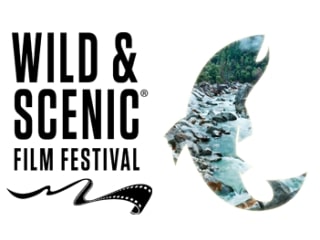
On Wednesday, February 22 and Thursday, February 23, fans of the annual, nationally acclaimed Wild & Scenic Film Festival packed the Chester County Historical Society to enjoy food, friends, and films in support of Stroud™ Water Research Center and The Land Conservancy for Southern Chester County. After hosting four successful seasons of the festival, which centers around environmentally themed short films, Trail Creek Outfitters added a second evening this year. It was a double treat for those who attended both evenings, with different films and fare each night.
Water has been a recurring theme throughout the festival year after year as attendees learn more about the importance of environmental stewardship. This year was no different. The slate of films featured skiers swishing down powdery slopes; paddlers chasing water down the Colorado River, hoping to reach the sea; a pair of artists collecting plastic beach litter; and more. They all pointed to the need for a better understanding and appreciation of life on Earth, which depends on water.
When Pete McBride caught an aerial view of the Colorado River in Chasing Water, he could see how many straws were sucking it dry. He had gained a kind of clarity that only comes with seeing the big picture, and that is what Stroud Water Research Center scientists and educators work toward every day. By studying freshwater streams and rivers, they are helping to connect the dots in our intricate and interdependent natural world.
“This event helps support a local Chester County institution, Stroud Water Research Center, which is renowned worldwide for their excellence in research, education, and stewardship for fresh water resources around the globe. We are extremely pleased to host this film festival to benefit the outstanding work done by all the members of the Stroud Center,” said Brian Havertine, co-owner of Trail Creek Outfitters.
“It was very interesting, and I learned a lot. I’ve learned something each time I’ve attended the festival, and it motivates you to want to make a difference. Plus it’s great that it’s supporting two organizations that are also committed to making a difference. I’ve always gone home from the film festivals smiling and glad I’d come,” said Jill Benjamin
Attendees were treated to tasty nibbles from Triple Fresh Catering Wednesday night and local, organic foods from FarmTable Gathering Thursday night. A variety of beers were donated by Dogfish Head Craft Brewery, and Paradocx Vineyard donated the wine. Raffle prizes from Trail Creek Outfitters, Stroud Water Research Center, and The Land Conservancy of Southern Chester County were a huge hit.
The Wild & Scenic Film Festival was made possible by the generous support of national sponsor Patagonia, Inc. and local sponsors Exelon, Dogfish Head Craft Brewery, Triple Fresh Catering, Paradocx Vineyard, WH2P Marketing Communications, Whole Foods Market, FarmTable Gathering, SIW, and others.
In the News
Stroud Center Scientists Share Data and Co-Author Paper on Nitrogen-Rich Forests
Stroud™ Water Research Center scientists Denis Newbold and John Jackson co-authored a paper with Jack Brookshire of Montana State University (formerly of Princeton University) and Lars Hedin and Daniel Sigman of Princeton University on nitrogen-rich tropical forests. Nature Geoscience published the paper in the journal’s online Jan. 15 edition. The paper reported on a study that utilized data sets from the Stroud Center’s work in Costa Rica.
Read more about the team’s findings on Montana State University’s website.
Stroud Scientists and Educators Present
Our ability to disseminate our findings to a broad audience allows us to increase awareness and create a public dialogue centered on the protection, preservation, and restoration of watersheds everywhere. It’s for that reason that our scientists and educators engage in both scientific and public forums to share their findings. The following highlights recent presentations.
KARWAN PRESENTS CZO AND STORM RESEARCH
Postdoctoral Associate Diana Karwan had a busy winter season hosting two presentations on storm-related research. On Dec. 7, 2011 she gave a poster presentation, “Within-Storm and Seasonal Differences in Particulate Organic Material Composition and Sources in White Clay Creek, USA,” at the annual meeting of the American Geophysical Union. The poster presented geochemical data from samples taken in White Clay Creek during storms in 2010 and 2011. CZO scientists Anthony Aufdenkampe, Denis Newbold, Rolf Aalto (University of Exeter), and Jim Pizzuto (University of Delaware) were co-authors on this poster.
She was also invited by scientists in the National Research Program to give a seminar at the United States Geological Survey (USGS) in Reston, Va. on Jan. 27, 2012. While there, she discussed ongoing research and possible future collaborations with members of the Hydroecology of Flowing Waters research group.
KAPLAN ON “THE SCIENCE BEHIND YOUR LIVABLE LANDSCAPE”
Your Livable Landscape is a project that describes how landscape decisions made by individual landowners impact the global carbon cycle. On January 17, 2012, Senior Scientist Lou Kaplan hosted a lecture on the current scientific understanding of the connections between the carbon cycle and the water cycle. The practical implications at the landscape scale involve the relationship of stormwater management to the carbon footprint of individual yards. The concepts presented helped landowners have an appreciation of their landscapes as dynamic ecosystems that process carbon.
ORIGAMI DRAGONFLIES (AND DAMSELS): MIXING ART AND SCIENCE AT THE FAIRMOUNT WATER WORKS INTERPRETIVE CENTER
Vivian Williams, a Stroud Center educator, showed attendees of the Science Saturday series at the Fairmount Waterworks how to mix art and science on Jan. 7, 2012. After learning about the life cycle and behavior of dragonflies, participants created an origami dragonfly using various artistic media to capture the patterns of local species. “Stream dragonflies and damselflies have been much more severely impacted by human activities than pond species,” said Williams.
SWEENEY PRESENTS CENTER WORK ON MACROINVERTEBRATES IN TROPICAL STREAMS
This February, Stroud Water Research Center Director Bern Sweeney traveled to San Jose, Costa Rica to give a presentation at the 1st Latin American Congress on Aquatic Macroinvertebrates. His presentation, “Ecology and Natural History of Macroinvertebrates in Pristine and Polluted Tropical Streams,” highlighted the Center’s research involving macroinvertebrates in Costa Rica and South America. Sweeney explained that the underlying philosophy for all of these studies has been that a thorough understanding of the ecology and natural history of macroinvertebrates in pristine streams is a necessary prerequisite to understanding and interpreting the response of macroinvertebrates in polluted streams.



